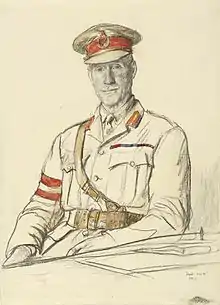Charles Woollcombe
Lieutenant General Sir Charles Louis Woollcombe KCB KCMG (23 March 1857 – 6 May 1934) was a British Army General during World War I.[2]
Sir Charles Woollcombe | |
|---|---|
 1917 portrait by Francis Dodd | |
| Born | 23 March 1857 Petrockstowe, Devon, England |
| Died | 6 May 1934 (aged 77) Bexhill-on-Sea, Sussex |
| Allegiance | |
| Service/ | |
| Rank | Lieutenant General |
| Unit | Second Boer War World War I |
| Commands held | Allahabad Brigade Garhwal Brigade Highland Division Eastern Command 2nd Army Central Force |
| Awards | Knight Grand Cross of the Order of the Bath Knight Commander of the Order of St Michael and St George Order of the White Eagle[1] |
Early life and education
Woollcombe was born in Devon, the eldest son of Rev. Louis Woollcombe, Rector of Petrockstowe, and Augusta Rundell Brown.[3] He was educated at Marlborough College. After begin a career as an accountant, he decided to enter the military and in 1876 entered Royal Military College, Sandhurst. He was a member of the football teams at Marlborough and Sandhurst.[2]
Military career
Woollcombe originally served with the 1st Devon Militia,[4] before obtaining a Regular commission in the 46th (South Devonshire) Regiment of Foot in 1876.[5] In 1877, he transferred to the 25th Regiment of Foot,[6] which was retitled as the King's Own Scottish Borderers in 1887. He took part in the Peshawar Valley expedition and the Khyber Line Force in Afghanistan between 1878 and 1880 and in the Chin Lushai expedition in Burma between 1889 and 1890.[7]
He was Deputy Assistant Adjutant General for Musketry in Bengal from 1890 and then Brigade Major for the Chitral Relief Force in Buram in 1895.[7] He then served on the North West Frontier in India becoming Assistant Adjutant General of the Mohmand Field Force in 1897.[7] He then took part in the Tirah expedition from 1897 to 1898 and then became Assistant Adjutant General in India in 1899.[7]
He served in the Second Boer War in South Africa and then became Assistant Adjutant General for Musketry in India between 1901 and 1906.[7]
He became Commander of the Allahabad Brigade in India in 1906, commander of the Garhwal Brigade in India in 1907 and General Officer Commanding the Highland Division in 1911.[7]
He served in the First World War as General Officer Commanding-in-Chief for Eastern Command from 1914 to 1915 when he became GOC of the 2nd Army, Central Force.[7] Then in 1916 he became GOC IV Corps.[8] Finally in 1918 he returned to his post as GOC-in-Chief at Eastern Command: he retired in 1920.[7]
Personal life
In 1886, he married Agnes Meade Murray, youngest daughter of General Sir John Irvine Murray. They had two sons, Malcolm Louis and 2nd Lt. Charles Stephenson, and a daughter, Joan. The younger son was killed in action while serving with his father's regiment, the King's Own Scottish Borderers, at the Battle of La Bassée on 12 October 1914.[2]
He died at his home, Chat Moss, Bexhill-on-Sea, Sussex.[2]
References
- Acović, Dragomir (2012). Slava i čast: Odlikovanja među Srbima, Srbi među odlikovanjima. Belgrade: Službeni Glasnik. p. 597.CS1 maint: ref=harv (link)
- "Obituary: Lieut.-Gen. Sir C. L. Woollcombe". The Times. The Times Digital Archive. 8 May 1934. p. 18.
- Burke, Bernard (1879). A genealogical and heraldic history of the landed gentry of Great Britain & Ireland. London, Harrison. p. 1786. Retrieved 6 June 2019.
- "No. 24389". The London Gazette. 1 December 1876. p. 6684.
- "No. 24492". The London Gazette. 14 August 1877. p. 4693.
- "No. 24492". The London Gazette. 14 August 1877. p. 4694.
- Sir Charles Louis Woollcombe Liddell Hart Centre for Military Archives
- The long, long trail
| Military offices | ||
|---|---|---|
| Preceded by Forbes MacBean |
GOC Highland Division 1911–1914 |
Succeeded by Colin Mackenzie |
| Preceded by Sir James Grierson |
GOC-in-C Eastern Command 1914–1915 |
Succeeded by Sir Leslie Rundle |
| Preceded by Edward Fanshawe |
GOC 11th (Northern) Division July–December 1916 |
Succeeded by Archibald Ritchie |
| Preceded by Henry Rawlinson |
GOC IV Corps 1916–1918 |
Succeeded by George Harper |
| Preceded by Sir William Robertson |
GOC-in-C Eastern Command 1918–1919 |
Succeeded by Lord Horne |
| Preceded by Sir Frederick Forestier-Walker |
Colonel of the King's Own Scottish Borderers 1910–1923 |
Succeeded by Sir Douglas Haig |